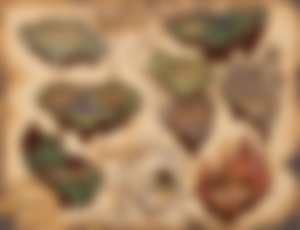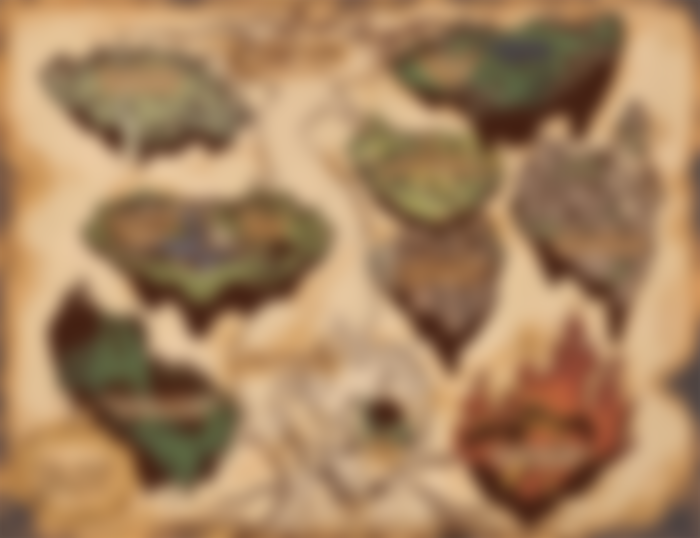The Nine Worlds-Norse Mythology
In the Scandinavian universe, the universe is divided into nine. The center of the universe was Yggdrasil, the great world tree, and these nine realms came into being, extending from the roots of the tree in an extraordinary way down and side by side.

Old Norse works (known as Eddic and Skaldic poetry) presuppose a knowledge of the universe and are not too concerned with the description of the places of the realms, or even the details of what the realms looked like in some cases. So the truth is that the Norse faith had no written scriptures, and some realms are less well known than others.
Scandinavian religious belief was characterized by the concept of síður (meaning tradition or habit), because this concept was fully integrated into people's lives. People did not participate in a religious ceremony in any place, such as a church, but observed the worship of the gods in their own homes, in a clearing in the woods, or in sacred places such as the underground. Although there is evidence that temples to the gods existed, there is no record of what kind of rites and rituals were performed there.
Icelandic mythographer Snorri Sturluson (1179-1241 AD) wrote the glorious Scandinavian epics, but the epics written were Christian scriptures and for Christian readers, thus changing the source information. Even the Volsung Epic, often said to embody "authentic" Norse beliefs by scholars, was finally written down by an anonymous Christian scribe (Crawford, ix) around 1250 AD.
Subsequent works undoubtedly point to much older and true Scandinavian stories, but the works are colored by the Christian context in which they were written. For example, Hel is thought to be a purely Christian concept that was added to Scandinavian cosmology after Scandinavia's introduction to the new religion, although the understanding of the afterlife was known by scholars as Niflhel in ancient literature.
The first nine realms in the Norse universe were:
-Asgard - realm of the Aesir gods
-Alfheim - realm of light elves
-Jotunheim - land of giants
-Midgard - Land of Men
-Muspelheim/Muspell - Fire giants or the land of chaos
-Nidavellir - Land of the Dwarves
-Niflheim - Land of ice and fog
-Svartalheim - Dark elf realm
-Vanaheim - Land of the Vanir gods
After Snorri's work, the nine realms were changed, as he mixed the dark elves with the dwarven realm and combined Nidavellir with Svartalheim into a single realm, he also added the concept of the afterlife realm, Hel as the most populous realm in the universe, and made other changes. According to Snorri Sturlison and those who wrote after him, the nine realms are:
Asgard - Realm of the Aesir gods connected to Midgard by the rainbow bridge Bifrost
-Alfheim - realm of elves
-Hel - The land of sickness, old age, and most people
-Jotunheim - Land of rock and ice giants
-Midgard - the land of humans located between Asgard and Jotunheim
-Muspelheim - Realm of Fire, featuring the fire giant Surtr and his power of chaos
-Nidavellir/Svartalheim - Realm of the underworld dwarves
-Niflheim - The land of ice, snow and mist located next to Muspelheim
-Vanaheim - Land of the Vanir gods
These nine realms were probably unknown to a pre-Christian Scandinavian, but they are the most distinctive depictions of the nine realms available today. The same is true of the story of the creation of the world and of people, which can vary widely, while the Scandinavian faith is a living, dynamic faith.
All these nine realms coexisted, they work together, and so on until Ragnarok. Independent of the nine realms and living together at the roots of Yggdrasil, the Norns determined the destinies of humans and gods. Like the Three Fates in ancient Greek belief, the Seven Hathors in Ancient Egyptian belief, or Shay (Shai), the god of destiny, the Norn's decisions were final and no one could challenge them. The Earth and all nine realms would be destroyed, and there was nothing anyone could do about it.
Ragnarok would begin with a harsh winter of ice and snow, followed by the fire giant Surtr, who would come and incinerate the world at the same time as the Midgard serpent was released, churning the surrounding waters and sinking the world. The great wolf Fenrir breaks his chains and swallows the sun.
The rainbow bridge Bifrost collapses as Yggdrasil is shaken, and the gods brace themselves for the final battle to save the ordered world they've built from the forces of chaos. The gods realize they will lose by going to war, but a handful of people will survive the final conflict and eventually a new world and order of realms will rise from the ashes of the old world.
This was the prediction of Scandinavian faith: one could be sure of death and the loss of all loved ones, but then there was something else. This prediction was true for the soul of people as well as for the world itself and everything in it. What else could have been a mystery, there is no source for what the new world might be like after Ragnarok, but there was always a new beginning, loss, and hope for the continuation of life in the other realms after death.

I have always been interested in Norse Mythology. It looks like Marvel's writers and creator of Thor and the rest of the Asgardian did a great deal of research when they created their version of Asgard and the rest of the 9 realms. Love this piece.